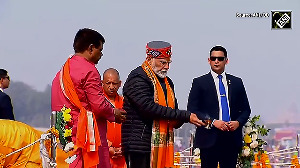When fashion designer Rohit Bal launched a new company, Balance, to handle his pret line, his main aim was to become a complete fashion and lifestyle brand.
But things are moving faster than expected. Balance has grown by around 100 per cent to 125 per cent in less than two years and four new stores are in the works.
The company also plans to enter London, Dubai and Thailand within the next year, and is in talks with financiers for long-term funding.
Bal isn't the only one taking new measurements in the prêt-à-porter business. For instance, Mumbai-based designer Narendra Kumar has entered an agreement with Banswara Syntex, a Rs 300-crore (Rs 3 billion) textile export company, to form his pret line Chai.
Ten stores are planned by 2005. And then there are players like Shopper's Stop and Raymond India, which have tie-ups with numerous designers for pret lines, and are expanding their galleries.
So what's so haute about pret? Vinod Kaul, executive director, Fashion Design Council of India (FDCI), reckons that Indian designers are simply trying to emulate foreign legends like Dior and Cardin who became global giants by shifting from upmarket couture into prêt-à-porter (ready to wear).
"Pret changed the face of fashion in Europe, making it a multi-billion dollar industry," says Kaul. "Couture was exclusive and prestigious but money-losing."
What's the market for pret wear? "People who see what page-three types are wearing and want similar designerwear at more affordable prices," says Joseph Sam, CEO and president, Balance, "which is why we've decided to keep a low mark-up on our pret wear."
The price tags at Balance are generally between Rs 1,500 and Rs 10,000. "Our way of keeping costs under control is to work backwards from our MRPs," says Sam. There are between 75 and 90 styles per season, and the number of pieces varies, depending on city and store.
Bal was among the first to get off the blocks with Balance, in October 2002. "Rohit was already an established name and Balance was a natural extension of the Rohit Bal brand," says Sam. "So we decided to hire more people and put in a set of processes."
Around Rs 10 lakh (Rs 1 million) to Rs 15 lakh (Rs 1.5 million) was invested in each store. The label currently has two stores in Delhi and Mumbai, a third is opening in Bangalore next month and Sam says plans are underway for three more -- in Hyderabad, Delhi and Mumbai.
There's more. "Through multi-brand outlets, we will enter places like Dubai and London in the next year," says Sam. "We are also trying to get into Thailand through a franchise and are on the verge of signing up with an investor."
Sam is confident about the company's growth prospects too. Balance has seen a growth of around 100 to 125 per cent in less than two years. The CEO says a 100 per cent growth is projected for the next three years.
Then, there's designer Narendra Kumar who tied up with Banswara Syntex to form his pret line, Chai a few months ago.
One store was opened in Bangalore in February this year, a second will follow soon in Mumbai and 10 are planned by 2005.
Shaleen Toshniwal, director, Banswara Syntex, says the company has already invested Rs 1.5 crore (Rs 15 million) in the project.
The Chai stores will provide womenswear at much lower prices than couture -- ranging between Rs 400 and Rs 1,200. Between 100 and 1,000 pieces per design will be available.
Naturally, this means that the designer won't be involved in the manufacture of every piece. However, Toshniwal insists that Kumar will see each piece before it is approved for sale.
At another level, there's Shopper's Stop, which was among the first players to get into the business by starting a pret line with designer Ravi Bajaj way back in 1997.
"We were ahead of our time then," says Sumit Chandna, category manager, Shopper's Stop, "but today's market is more mature, and ready."
Shopper's Stop began taking pret more seriously around a year ago. A designer gallery, Buzz, was opened over 2,000 square feet in the Orbit Mall in Mumbai, with pret lines by nine designers -- including Bajaj, Bal and Suneet Verma.
Chandna is excited about pret's prospects. "The business has undergone a big change over the past two years," he says.
"Events like the Lakme India Fashion Week have increased consumer awareness and now more is happening with each successive season."
For Shopper's Stop, this translates into the opening of two more Buzz galleries in the next two to three months.
Textile giant Raymond was also an early entrant into the pret business with its Be: stores. Be: has tied up with 15 designers, including big names like Bal, Rathore and Puja Nayyar.
While these are not exclusive arrangements, Anirudha Deshmukh, executive director, Raymond, says that "a significant proportion of the lines available to us are not available elsewhere".
Be: currently has eight exclusive stores in India as well as one in Dubai. Five more exclusive stores will open in the next year. Depending on the type of apparel, the pret line available at Be: stores costs between Rs 600 and Rs 7,000.
But there are some who aren't ready to catwalk down the pret-a-path just yet. Like designer Sabyasachi Mukherji who, despite being a fairly well known name on the fashion circuit, thinks he needs more time to establish himself.
"I don't want to be swallowed up by the big corporates," he says. "I'd prefer to wait another two years or so, until I have more bargaining power."
Mukherji adds, "Pret is about expansion, as well as marketing. You can do wonderful couture shows with just two or three tailors."
Other designers have made inroads into pret but are treading cautiously for now. Like Raghvendra Rathore, who has a pret line called Indi Pret.
Rathore is wary of the herd mentality that might see companies rushing blindly into pret lines without being prepared enough.
"A lot of adjustment is required," he says, "It's like opening and maintaining a small restaurant."
Indi Pret currently has a presence in multi-brand outlets and the plan eventually is to have exclusive "Rathore stores".
But as Vishal Singh, who bought a 50 per cent share in Indi Pret recently, says: "We want to first evaluate which areas are ready for exclusive pret stores and then consolidate our plans."
Of course, shifting from being an exclusive couture label isn't an easy task. In the west, giants like LVMH manage the pret lines of leading designers. But in India, the industry is still at the nascent stage. "Most top names are still in couture mode," says Kaul.
Changing this is easier said than done, because the shift from couture to pret demands certain fundamental changes. Firstly, says Kaul, the designers' mindset must change.
"Unlike couture, which is meant for special occasions, pret wear has to be both affordable and wearable," he says. "This means that designers will have to reinvent themselves to an extent."
Potential problems of miscommunication between designers and money-minded corporates also have to be overcome.
Besides, infrastructural changes are required. The scale of operations being much larger than for couture, production units have to be bigger.
Also, as Kaul observes, "quality parameters automatically change when you're making 20 pieces as compared to just one."






 © 2025
© 2025